The Place of Artists’ Cinema
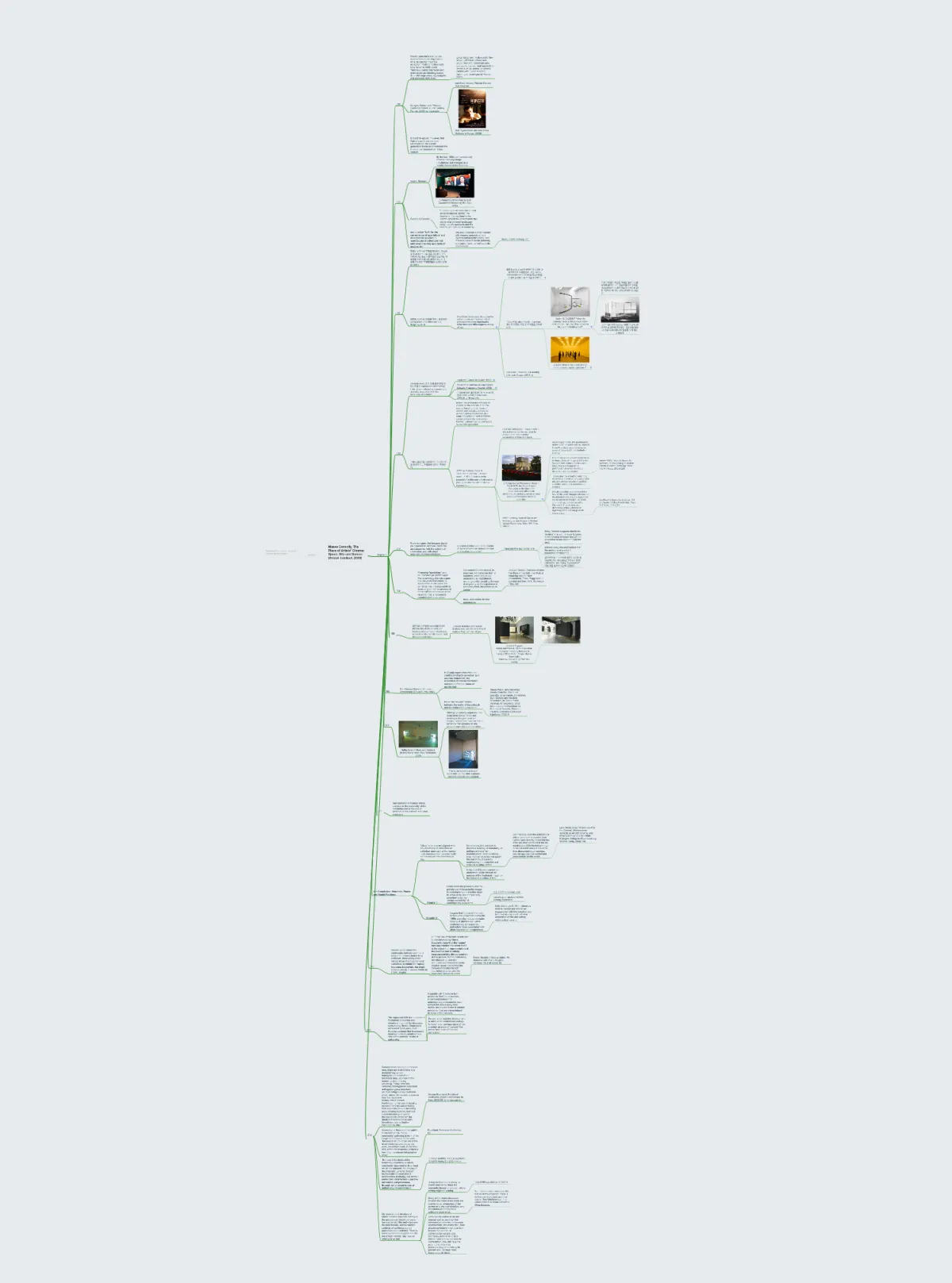
Reference: Maeve Connolly, The Place of Artists’ Cinema: Space, Site and Screen (Bristol: Intellect, 2009)
Chapter 5
165
- Recent years have seen a new wave of artists directing feature films devised for theatrical exhibition. Profiling ‘Hollywood’s New Wave’ in 2006, Linda Yablonsky claims that ‘more and more artists are directing feature films with large casts, big budgets, and elaborate story lines’.
- Linda Yablonsky, ‘Hollywood’s New Wave’, ARTNews, (December 2006): 112–117. One might also add works that use well-known film actors such as James Coleman’s Retake with Evidence (2007), featuring a monologue by Harvey Keitel.
- Douglas Gordon and Philippe Parreno’s Zidane: A 21st Century Portrait (2006) as a example
- And Shirin Neshat, Pipilotti Rist and Piotr Uklanski
- Sam Taylor-Wood and also Steve McQueen’s Hunger (2008)

- It could be argued, however, that Warhol’s work also remains significant for the current generation because it contested the limits of the theatrical exhibition context.
166
- Venice Biennale
- By the late 1990s, self-consciously cinematic moving image installations had emerged as a notable feature of the Biennale.
- Turbulent by Shirin Neshat and Consolation Service by Eija-Liisa Ahtila

- Giardini di Castello
- Functioning as emblems (or at least relics) of national identity, the situation of the pavilions in the Grardini specifically foregrounds the relationship between landscape design, public spectacle and the material architecture of modernity.
- any structure ‘built for the convenience of spectators’ and described the pavilion as ‘spectacular architecture that embraced the very spectacle of modern life’.
- She also proposes a direct parallel with cinema, understood as a ‘quintessential public space: and inclusive place of social gathering and public transit as well as a site of spectacle’.
- *Bruno, Public Intimacy, 57.
- She also proposes a direct parallel with cinema, understood as a ‘quintessential public space: and inclusive place of social gathering and public transit as well as a site of spectacle’.
167
- 작가는 부루노의 주장을 반대하며, 파빌리옹과 시네마의 다른 점을 강조한다. 지아디니 디 카스텔로 파빌리옹은 프로젝트 이미지를 위해 만들어진 공간이 아니며, 건축적 요소들은 프랙틸컬함에 의해서 선택된 것이다.
- 최근의 시네마와 건축의 교차는 불규칙한 explorations of architecture and design by artist.
- Alex Coles historicizes this current in a short article on ‘Pavilions’, which references works by Rodchenko, Schwitters and Allan Kaprow among others.
- 또한 Dan Graham과 올라푸 엘리슨을 그 대표주자로 바라봤는데, 그는 Olafur Eliasson와 Dan Graham을 파빌리옹을 시네마 전시를 이을 작가로 주목한다.
- 그러나 또한, Alex Coles은 , ‘Pavilions’ 에서 두 작가의 가장 큰 차이점을 지적했는데
- Graham의 파빌리옹은 ‘bring the beholder back to the surface of the work and so insist that they reflect on the act of beholding itself’,
- Alex Coles historicizes this current in a short article on ‘Pavilions’, which references works by Rodchenko, Schwitters and Allan Kaprow among others.
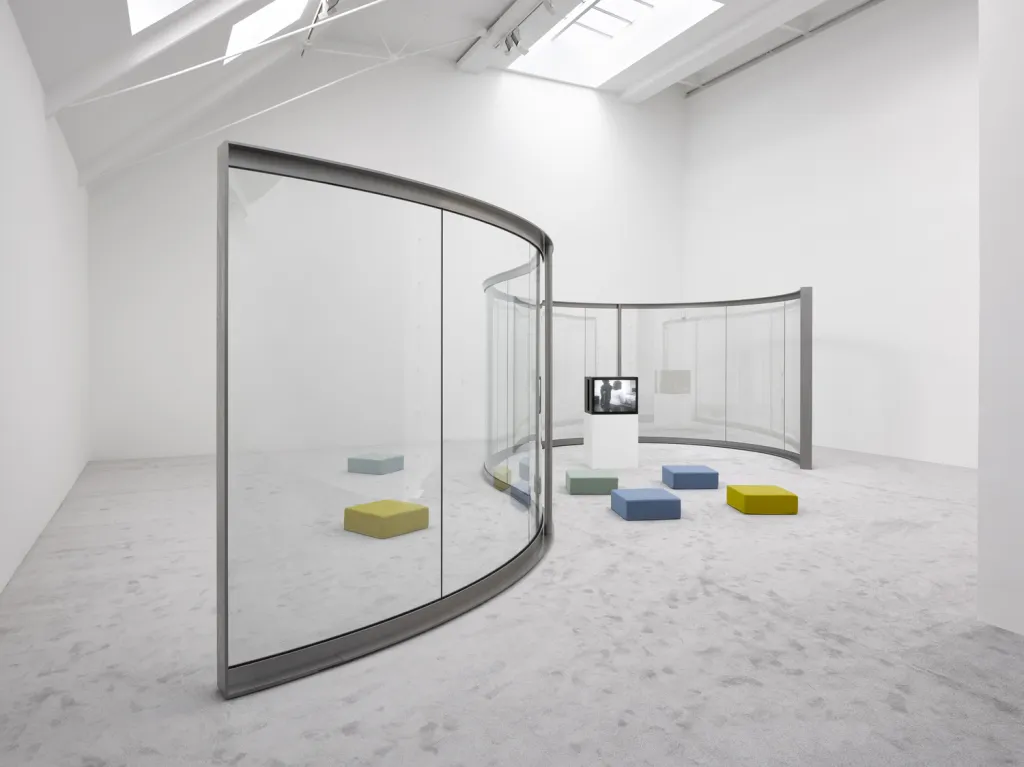
- 또한 그라햄의 작업은 막다른 길에 다다를 수밖에 없다며 그가 컨셉츄얼하게 건축물에 접근하면서 컨템의 아트의 디자인을 향한 바운더리를 깨는 것에 실패한다고 보았다.
- 그의 다른 작업 Cinema (1981)의 경우 설계도면과 글로만 존재하며, 유리면을 통해서 안과 밖에서 동시에 필름을 보게 할수 있게했다.

- Eliasson offers a ‘less cerebral and more phantasmagoric experience’.

- Alex Coles, ‘Pavilions’, Art Monthly 308, (July–August 2007): 3.
168
- Chrissie Iles의 경우 현재 많은 컨템 아티스트들의 explorations of cinema는 likely to be mediated by memory and nostalgia associated with the materiality of celluloid.
- Deadpan (Steve McQueen, 1997)
- Trailer for a Remake of Gore Vidal’s Caligula (Francesco Vezzoli, 2006)
- 그 이유에 대해 셀루로이드가 ‘in crisis’에 있다고 보며 Kodak (Tacita Dean, 2006)를 그 예시로 든다.
- 그러나 글쓴이는 시네마틱의 크라이스가 주 주제가 아닌 작품들이 있다고 주장한다.
- In fact, the articulation of a love of cinema, at the moment of its ‘loss’, may be linked to other forms of anxiety and nostalgia, articulated across a variety of practices, in a range of production and exhibition contexts where the relationship between cultural memory and public space is foregrounded.
- 그 예시로 Anthony Vidler ➡︎ ‘architectural uncanny’, ‘warped space’, 컨셉으로 focuses on the potential of architecture to both mark a place (as landmark) and articulate a response to it.
- He is also interested in ways in which physical place may be mediated by virtual rather than material experiences of time and space.
- 그 예시로 Rachel Whiteread’s House 의 작업을 들며, the focus of much discussion at the time of its production and subsequent demolition, illustrates a certain anxiety about contemporary forms of spatiality.
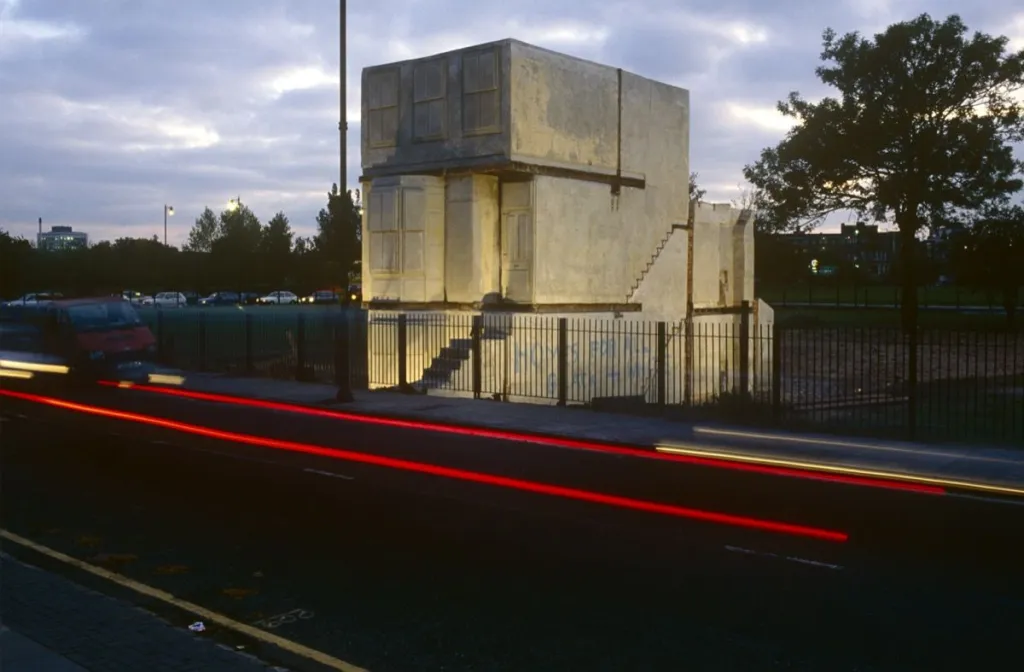
- According to Vidler, the proliferation of the ‘void’, in works such as House is linked to a discernible nostalgia for space at the end of the twentieth-century. – (169) There is not only no room for us in House, there is no space left either. Space is both denied and destroyed; filled, where a modernist or postmodernist sensibility would demand that it be opened.
- Antony Vidler, Warped Space: Art, Architecture and Anxiety in Modern Culture (London;Cambridge, Mass: The MIT Press, 2000) 236.
- – it indicates the extent to which the experience of even an unquestionably physical artefact may be shaped by anxieties concerning emptiness or absence. – It is also possible to understand the fear of the ‘void’ through reference to the theorizations of public space that are advanced by Rosalyn Deutsche, among others, and discussed in Chapter 3. Emphasizing that democracy actually derives its legitimacy from ‘the image of an empty place’,
- ::See Rosalyn Deustche, Evictions: Art and Spatial Politics (Cambridge, Mass: MIT Press, 1996) 273.::
- ::Vidler, Anthony, Warped Space: Art, Architecture, and Anxiety in Modern Culture (Cambridge, Mass: MIT Press, 2000)::
619
- Roberts argues that because digital (as opposed to ‘archival’) mediums are concerned with the delivery of information and with direct networks of communications,
- any kind of informational translation of experience to be passed on from one location to another’
- There are two key points here:
- firstly, Roberts suggests that in the ‘archival’ medium, time participates in the creation of space through the separation of one moment from the next,
- and secondly, she emphasizes that the archival is aligned with processes of translation.
- 결국 디지털 미디어에서 시간과 공간은 트렌스래이션의 프로세스로 지정되는데 하나의 데이터 공간 안으로 ‘트렌스레이션’ 되는 것을 통해서 시간이 지정된다.
- There are two key points here:
- any kind of informational translation of experience to be passed on from one location to another’
179
- Proposing ‘hauntology’ as a counterpoint (or corrective) to Marx’s ontology, Derrida argues that the ghost first makes its appearance in use-value. He contends that it is impossible to locate a ‘pure use’ in advance of commodification because of the repetition that is necessarily associated with use-value.
- Use cannot be determined, he proposes, without some form of repetition, which should be understood as ‘substitution, exchangeability, iterability, the loss of singularity as the experience of singularity itself, the possibility of capital’.
- ::Jacques Derrida, Specters of Marx: The State of the Debt, the Work of Mourning and the New International, Trans. Peggy Kamuf, (London and New York: Routledge, 1994) 202::
- there, even before its first appearance.
- Use cannot be determined, he proposes, without some form of repetition, which should be understood as ‘substitution, exchangeability, iterability, the loss of singularity as the experience of singularity itself, the possibility of capital’.
180
- 다른 아티스트들이 Vezzoli를 예시로 theatricality of the cinema and Demans offers a more metaphorical exploration of cinematic illusion and the commodity form
- 그 예시로 ➡︎ Kultur und Freizeit (Culture and Leisure) is the title of Andreas Fogarasi’s installation
- Andreas Fogarasi Kultur und Freizeit, 2007 Installation, Hungarian Pavilion, Biennale di Venezia 2007 Photo: Tihanyi-Bakos-Fotostudio Courtesy: Georg Kargl Fine Arts, Vienna
- 그 예시로 ➡︎ Kultur und Freizeit (Culture and Leisure) is the title of Andreas Fogarasi’s installation
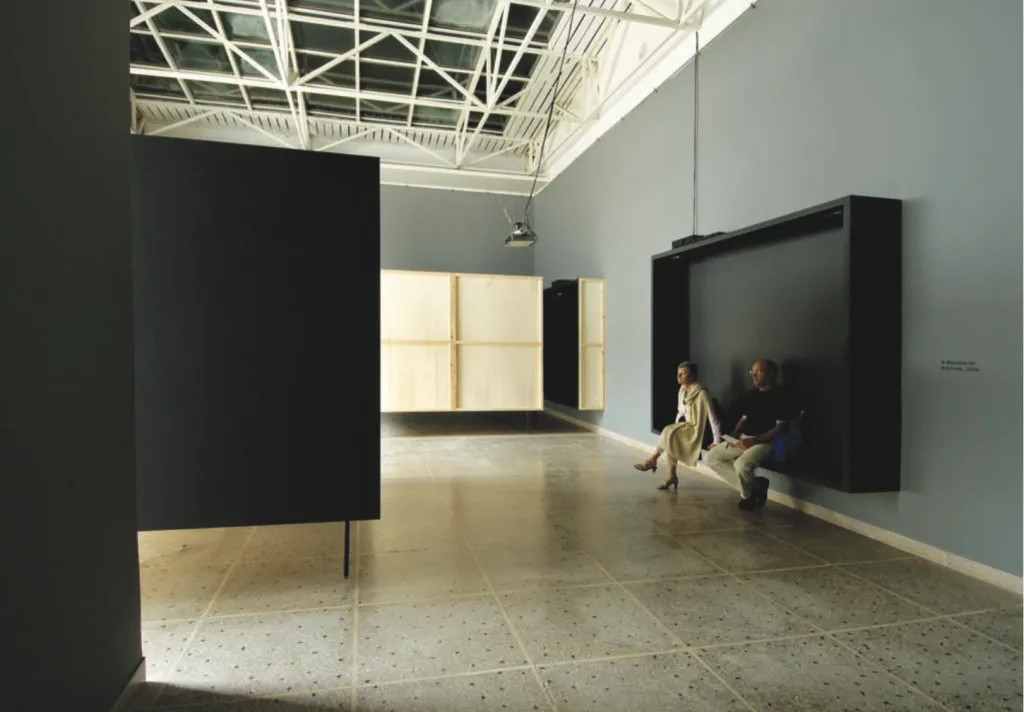
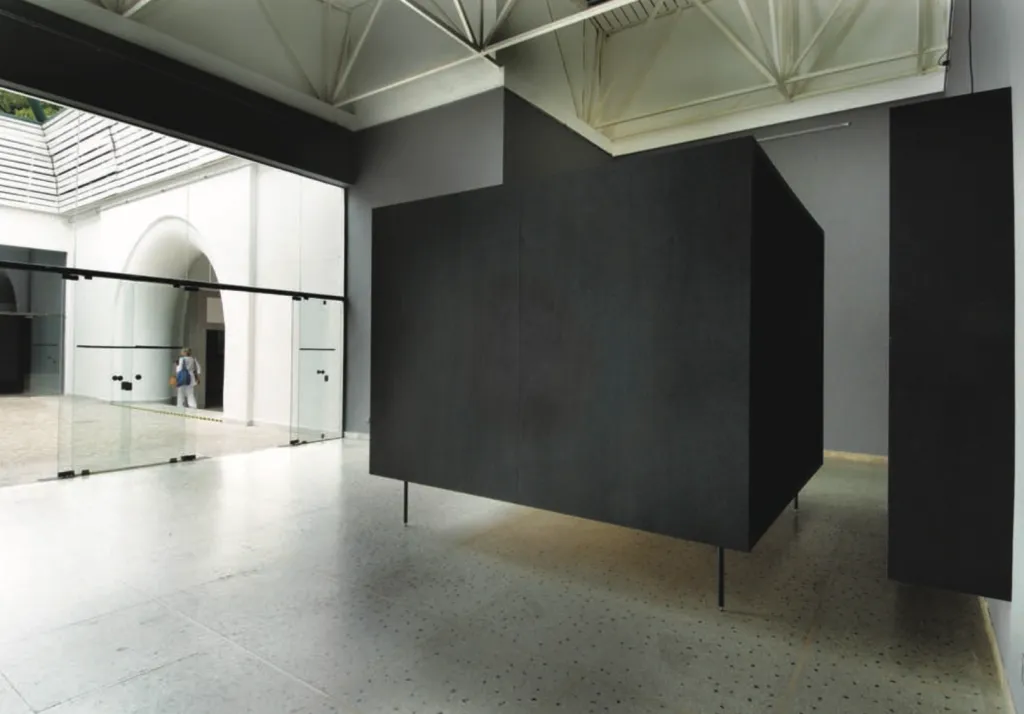
186
- The Cinema Machine: Venetian, Atmospheric (Tobias Putrih, 2007)
- He(Putrih) argues that while the creation of objects served as ‘as a counter-statement’, the exploration of cinema structures and forms offered a ‘place of equilibrium’.
- It’s an “in-between” space: between the reality of the sidewalk and the fiction of the projection’.
- ::Tobias Putrih, interviewed by Nataša Petrešin, ‘On Quasi-scientific Experiments, Collectively Built Objects and Random Structures’, in Tobias Putrih, Venetian, Atmospheric, 52nd International Art Exhibition La Biennale di Venezia, Slovenian Pavilion, Exhibition Catalogue (Ljubljana, 2007) 5.::
198
- Reflections of State and Subject: [in,the] visible state (Bea McMahon, 2008)
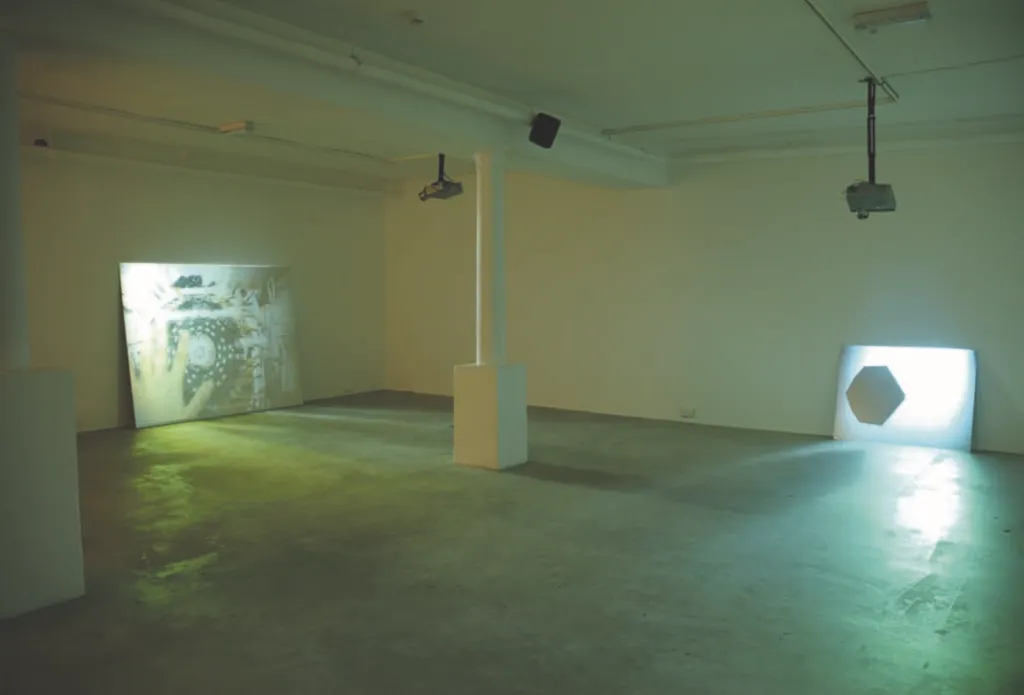
- Although physically separated, the projections are synchronised, creating a dialogue between images, sounds and texts so that a sentence that appears on one screen is completed on the other.
- The screens are coated with buttermilk so that their surfaces become clouded and opaque
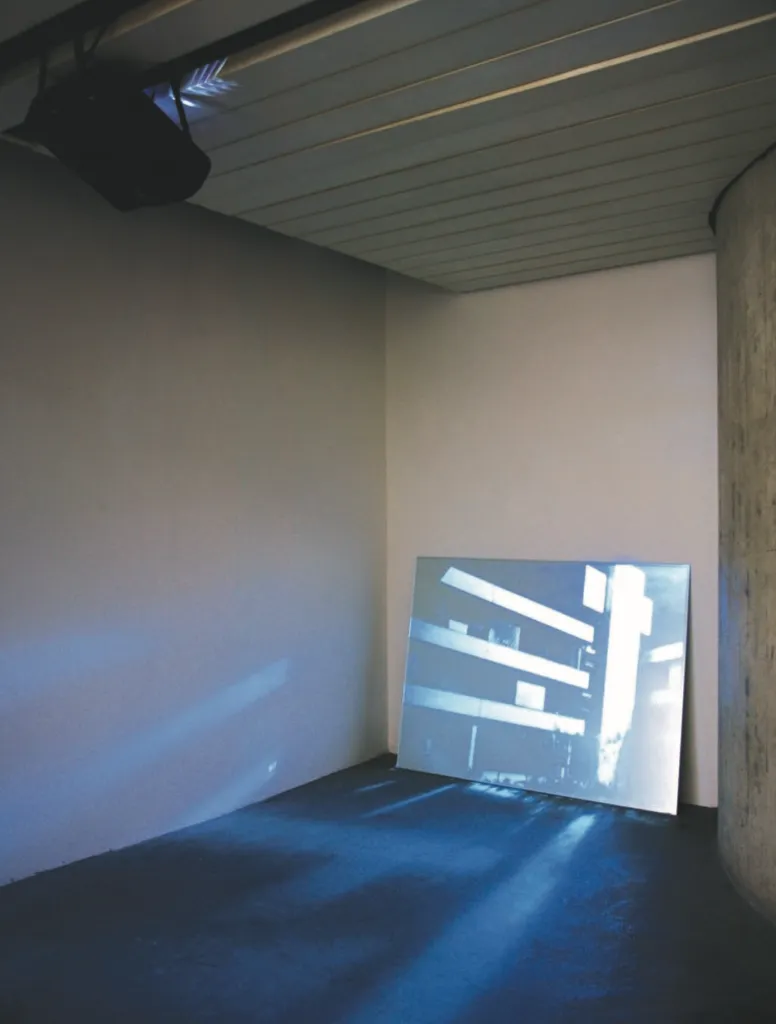
202
- Bea McMahon’s strategy draws attention to the materiality of the installation and to the role of reflection in the creation of a video projection.
Conclusion: Materials, Places and Social Relations
211
- Artists’ cinema is not aligned with any one mode of production or exhibition and many of the works I have discussed are not specifically concerned with the materiality of film.
- Nonetheless, it is possible to discern a recovery of materiality, or perhaps a kind of ‘re-materialization’, in the relatively small number of works that assert the specificity of place by emphasizing the evidential and indexical qualities of film.
- Commenting upon the exhibition of artists’ cinema in museums, Lars Henrik Gass recently noted that the latter are often complicit in the ‘re-auratisation of the technical image in the art world’ while at the same time demonstrating a ‘careless, cavalier approach to context and presentation’ of film works.
- Lars Henrik Gass, ‘Afterword: After the Cinema’, Kinomuseum: Towards an Artists’ Cinema, eds. Mike Sperlinger and Ian White (Cologne: Verlag der Buchhandlung Walther König, 2008) 158.
- Commenting upon the exhibition of artists’ cinema in museums, Lars Henrik Gass recently noted that the latter are often complicit in the ‘re-auratisation of the technical image in the art world’ while at the same time demonstrating a ‘careless, cavalier approach to context and presentation’ of film works.
- In my view this issue cannot be understood solely through an analysis of the ‘technical image’, or the indexical qualities of film.
- Nonetheless, it is possible to discern a recovery of materiality, or perhaps a kind of ‘re-materialization’, in the relatively small number of works that assert the specificity of place by emphasizing the evidential and indexical qualities of film.
- Chapter 1
- I considered the possibility that the prevalence of the projected image in contemporary art practice might, by virtue of its very immateriality, somehow index the ‘unrepresentability’ of contemporary experience.
- ::이건 아마도 ephemeral, void::
- rise of a post-productive free-floating capitalism.
- I considered the possibility that the prevalence of the projected image in contemporary art practice might, by virtue of its very immateriality, somehow index the ‘unrepresentability’ of contemporary experience.
- Chapter 3
- I argued that the rise of the multi-screen video projection during the 1990s was informed by a broader staging of ‘publicness’ within contemporary art museums, particularly those associated with urban regeneration programmes.
- Willie Doherty’s Re-Run. Doherty’s work is marked not only by an engagement with film structure and form but also by a self-reflexive exploration of site and setting within artists’ cinema.
- I argued that the rise of the multi-screen video projection during the 1990s was informed by a broader staging of ‘publicness’ within contemporary art museums, particularly those associated with urban regeneration programmes.
- several works where the relationship between event and document is complicated by a deliberate intertwining of the temporalities of production and exhibition, in which the ‘replay’ becomes folded into the event, most obviously in various works by Pierre Huyghe.
- (111) My use of the term ‘event-site’ is also informed by Pierre Huyghe’s claim that the ‘replay’ now supersedes the event itself, to the extent that representation of the event is now routinely incorporated into the conception of the project. Before addressing the relationship between
- site, event and document, some broader issues concerning the concept of location in both installation practice and film production should be noted.
- ::Pierre Huyghe in George Baker, ‘An Interview with Pierre Huyghe’, October 110 (Fall 2004): 83.::
217
- The supposed shift from material to immaterial labour has also structured much of the discourse surrounding Nicolas Bourriaud’s account of ‘post-production’. Roberts contends that Bourriaud’s thinking is directly indebted to a ‘bio-computational’ model of authorship.
- In parallel with this move from citation to ‘flow’ in art practice, Robert emphasises that contemporary art museums have shifted their focus away from display and toward forms of cultural production that are characterised by a low artistic visibility.
- He seems to read this development in terms of an institutional strategy to redefine (or perhaps rebrand) the museum as a site of ‘cultural flow’ rather than ‘a site of cultural domination’.
218
- Sacredness is making a comeback here, there and everywhere. In a muddled way we are hoping for the return of the traditional aura…A phase in the modern project is being wound up. Today, after two centuries of struggle for singularity and against group impulses, we must bring in a new synthesis which, alone, will be able to save us from the regressive fantasy that is abroad. Reintroducing the idea of plurality, for contemporary culture hailing from modernity, means inventing ways of being together, forms of interaction that go beyond the inevitability of the families, ghettos of technological user-friendliness, and collective institution on offer.
- ::Nicolas Bourriaud, Relational Aesthetics, (Dijon: Les Presses du Reel, 2002) 60. Emphasis added.::
- According to Bourriaud, the public, in the form of the ‘micro-community’ gathering in front of the image, is the source of the aura: ‘the aura of art no longer lies in the hinter-world represented by the work, nor in form itself, but in front of it, within the temporary collective form that it produces being put on show’.
- ::Bourriaud, Relational Aesthetics, 61.::
- But even if the limits of the temporary collectivity or micro- community described by Bourriaud are all too apparent, the staging of the cinematic, whether through technologies of projection or architectures of display, can involve some form of reflection upon the structures and processes through which experiences of collectivity are constituted.
- ::이 부분은 동의한다. 기기적인 프로젝션이건 건축적 display건 비판적 critique::
- My research into the place of artists’ cinema responds directly to the pronounced visibility of certain forms of artists’ film and video over the past decade, across multiple contexts of contemporary art production and exhibition. There is some evidence to suggest that this era of high visibility may now be coming to an end.
- It may be that the tendency to overtly and visibly stage the cinematic through projection, site or setting might be waning.
- 그래서 어떤 possibbiliies 란 말인가?
- Many of the works discussed towards the close of my study are marked by an awareness of the screen as a physical structure, and the cinema as setting for a collective experience.
- Yet in some recent examples, the display of the projected image is deliberately frustrated, as in the case of Bea McMahon’s [in,the] visible state or Aurélien Froment’s White Balance.
- Although the notion of ‘artists’ cinema’ seems destined (like television) to become increasingly anachronistic, the works discussed should continue to merit attention beyond the context of contemporary art practice. Ultimately, even when artists’ claims upon cinema are open to contestation, they still have the potential to inform an understanding of its history, its present and, perhaps most importantly, its future.
- It may be that the tendency to overtly and visibly stage the cinematic through projection, site or setting might be waning.

